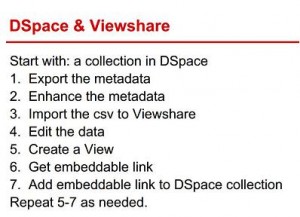This is a guest post from Camille Salas, an intern with the Library of Congress.
Meghan Frazer is the Digital Resources Curator for the Knowlton School of Architecture at The Ohio State University. She previously worked as a digital resources librarian at Kenyon College where she was the first recipient of the Rick Peterson Fellowship. The Fellowship is awarded to an early career IT professional or librarian who led a collaborative effort to resolve a significant challenge in IT/digital libraries.
CS: You recently gave a presentation at the Library and Information Technology Association (LITA) Forum entitled “Collections Amplified” (PDF). The presentation describes how you used three different available data tools, including Viewshare. Tell us about the core idea of your talk? What do you mean by the term “collections amplified”?
MF: The idea of “amplifying” collections comes from the desire to do more with a collection after items have been described and archived in a digital repository. The talk described a method for embedding visualizations into DSpace collections using only the administrative interface. By using the tools described to create a map or timeline and then displaying the result on a collection or community homepage, we can improve the visual experience of our users.
CS: Why is improving the “visual experience” of your users important for someone in your role? It would be great to hear your perspective on why it’s important for users to have these visualizations and for information professionals to have the knowledge to create them.
MF: A good visual experience is important because we are more likely, as users, to spend time with websites that are easy and interesting to use. While subject experts may use the collection regardless of its interface, I think you can reach a wider audience by attending to the presentation of the items. In the specific case of data visualizations, I also think it provides a way for researchers to present the patterns they see to users of the website, in a way that a list of items cannot.
CS: Please walk us through how you used Viewshare to amplify a collection and what prompted you to use the tools in combination?
MF: First, I exported the collection’s metadata from DSpace and cleaned it up a bit to create a csv file. I then imported the csv file to Viewshare to create a new data set. Next, I used the “Build” function to create views which can then be embedded back into DSpace using the embed code provided by Viewshare. There is a step-by-step description of the process available in slideshare (slides 43-56 specifically address Viewshare) and also at the ACRL TechConnect blog.
CS: In using Viewshare and DSpace together, what did you learn about them individually? Did your thinking about them change at all in using them together?
MF: In researching these processes, it became increasingly clear to me that wanting one tool to do everything is not realistic. Viewshare and DSpace perform their respective functions extremely well, and building a bridge between them allows a user to have the best of both worlds.
CS: Please tell us a bit about how your presentation was received at the LITA forum? What kinds of comments and questions did the audience have for you?
MF: After going through the step-by-step process on a demo DSpace site, we talked more about how to utilize this process using one or more different tools. For example, I pointed them to the existing tutorial on Viewshare and Omeka.
CS: Given your experience with Viewshare, are there any other features you would like to see that would enhance how information professionals use it? Any suggestions for how it might better amplify collections?
MF: The best thing tools like this could do is allow for dynamic updating. Technically, of course, this would be a huge hurdle, but the current process requires me to re-export and re-upload my data whenever it changes. In the case of DSpace collections, for example, if an item is added to a collection, updating the corresponding visualization in Viewshare requires a repeat of the whole process. If instead, the dataset could be set to update itself from the original collection at a set time interval, for example, that would be a great feature.



